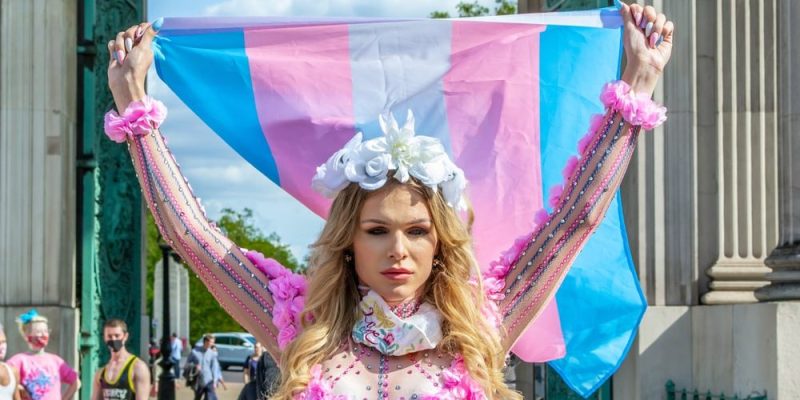We explain what transsexuality is, its history and other gender identities. Also, what are the stages of sex change.

What is it to be transsexual?
Transsexuality (sometimes also called transsexualism) is the gender identity of people who consider themselves individuals of the opposite sex to which their bodies naturally present. Thus, trans women are those who were born with a male body, but identify themselves as women; while trans men are those who were born with a female body, but identify themselves as men.
Transsexuality is a gender identity different from the traditional one, part of the spectrum of transgender identities. This means that it is different from cisgender or cisthose whose biological sex corresponds to their psychological or emotional gender identity. Transsexual people often hide the sexual characteristics of their own body, adopt the traditional clothing of the opposite sex, and even undergo treatments and surgical interventions in order to reassign their sex.
Transsexual people typically identify with the label transor with “umbrella” terms like non-binary non-binary gender or as sexually diverse people. The purpose of these categories is to be as least exclusive as possible, given that throughout the history of humanity people trans They have been marginalized, rejected and stigmatized as psychiatric patients, sexual deviants or even criminals and delinquents.
Transsexuality is a very rare identity condition, typical of approximately 0.3% of the world's population but strongly stigmatized and even persecuted in much of the world. Transsexuality and the possibility of gender reassignment (legal and/or surgical) is illegal in many countries and was considered a mental illness until the end of the 20th century.
It is important not to confuse transsexuality with transvestism (the often erotic taste for wearing the traditional clothes of the opposite sex), or with intersexuality (a medical condition also known as hermaphroditism).
Nor should it be confused with any existing sexual orientation, since A trans person can be attracted to men, women, or any gender identity. Gender identity refers only to the way an individual internally conceives themselves, not to erotic-romantic tastes and affinities.
History of transsexuality
It is complex to trace a history of transsexuality, since There is evidence of trans people in ancient mythological traditions and even in ancient cultures like India, where there is the possibility of recognizing a “third sex.”
The study of transsexuality itself began in the mid-19th century when the still young disciplines of psychiatry and psychoanalysis became interested in the so-called “identity disorders,” which mainly had to do with sexual identity, that is, with whether people identified themselves as men or as men. women and why.
Studies on the subject by doctors and psychologists such as Nikolaus Friedreich (1825-1882), Jean Étienne Dominique Esquirol (1772-1840), Richard von Krafft-Ebing (1840-1902), and then in the 20th century by Havelock Ellis (1859 -1939) and Magnus Hirschfeld (1868-1935) were important in the recognition of the homosexual and transsexual condition, despite the fact that these were initially considered “deviations”.
Such is the case of the German endocrinologist Harry Benjamin (1885-1986), who coined the term transsexual for patients who were treated with hormonal supplements of the sex with which they identified.
Since 1977, however, the WHO included transsexuality as a medical syndrome, and not as a mental illness. This is how it currently appears in official medical documents such as the DSM IV (Diagnostic Manual). However, pressure from protesters around the world led the WHO to include transsexuality in a section identified as “relative conditions of sexual health” in 2018, under the name “gender incongruence.”
gender dysphoria
“Gender dysphoria” is a medical term, which replaces the old “gender identity disorder” with which transsexuality was identified, understood at that time as a mental pathology. Gender dysphoria is defined as the deep discomfort or feeling of discomfort that the discrepancy between their biological sex and their gender identity produces in an individual. Which can bring with it problems such as depression, anxiety and other mental or emotional afflictions.
Gender dysphoria is a real problem in the community transa frequent cause of serious anxiety problems and even high suicide rates. Its origin continues to be studied by specialists, although it is not known whether it is due to genetic, environmental or hormonal causes during the embryonic stage or childhood.
sex change

Sex change is a complex procedure, still under study and definition, which consists of two stages:
- Chronic hormonal treatment of the individual to induce in him the secondary sexual traits of the sex with which he identifies.
- The subsequent surgical removal of those organs typical of their biological sex in addition to the eventual reconstruction of the desired genitalia. This involves surgeries whose purpose is to provide the transgender person with a body more in line with the gender with which they identify.
The first sex change surgeries took place in the 20th century although not always in the public light. The first known case took place in 1912, described by Hirschfeld, and it is known that there were subsequent cases thanks to his disciple Felix Abraham, and also that it was a practice in which doctors affiliated with Nazism were interested.
Famous, however, are the cases of the Danish painter Lili Elbe (legally Einar Mogens Wegener, 1882-1931), who asked Hirschfeld in 1930 to surgically convert her into a woman and died from the consequences of the operation; and the case of the American soldier George Jorgensen who in 1952 underwent a similar treatment with relative success, for which he changed his legal name to Christine Jorgensen.
Transgender and transsexual
The terms transgender and transsexual are often used interchangeably, and to a certain extent they can be synonymous, but they do not mean exactly the same thing. To understand this difference, it is important to start from the fact that there are several gender identities different from the traditional one (cisgender), one of which is, precisely, transsexuality. However, To name this set of divergent or alternative identities, the term is often used. transgender.
So every transsexual person is a transgender person. But Not every transgender person is necessarily transsexual: This category also usually includes agender, non-binary people, among other possible identities. On the other hand, the terms transsexual and transvestite still have a certain problematic connotation, given that they were used for decades to discriminate and pathologize people. trans.
Transgender pride flag

The community trans international has created a flag to identify its movement of struggle for visibility, recognition and institutional protection. This flag consists of a rectangle composed of five thick, horizontal stripes: one white in the middle position, two pink ones in the immediately nearby upper and lower position, and two light blue stripes in the outer positions, above and below.
This flag It was created in 1999 by American trans woman Monica Helms and used for the first time in the LGBT pride parade of the city of Phoenix, United States in 2000.
Transphobia
transphobia is the aversion, hatred or fear of transgender people and like other types of phobia (homophobia, for example) can lead to harassment, discrimination and even violence. The term “transphobia” is a neologism that emerged at the beginning of the 21st century, which seeks to make visible (and therefore de-normalize) the differential and pejorative treatment that transgender people often suffer, such as workplace discrimination, bullying and street violence, and even physical and sexual violence.
Other gender identities
In addition to transsexuality, other gender identities are currently recognized, such as:
- Cisgender. These are those people whose gender identity coincides with their biological sex. This does not mean anything about their sexual orientation, and therefore there are cis heterosexual people and cis homosexual people.
- Agender. These are those people who do not identify with any established gender identity, neither among the traditional ones (man-woman), nor in the trans spectrum. Agender people are also called “gender neutral.”
- fluid gender. These are people whose gender identity is not particularly stable, and oscillates between masculine and feminine, or even between other identities, depending on environmental conditions or the internal condition of the individual. Its genre, as the name of the category indicates, “flows” from one site to another.
- Non-binary gender or Genderqueer. These are those people who identify with a gender outside the traditional division between masculine and feminine, either because they embrace both genders at the same time, or because they do not identify with either, or because they assume certain aspects of both. It is an “umbrella” term for everything that is difficult to classify into other identities.
Continue with: Pansexual
References
- “Transsexuality” on Wikipedia.
- “Transgender” on Wikipedia.
- “Transphobia” on Wikipedia.
- “UNAM explains to you: Transsexuality” at Fundación UNAM (Mexico).
- “Transgender and transsexual, what is the difference?” at AHF Latam & Caribe.
- “Transgender (gender identity)” in The Encyclopaedia Britannica.
- “Transsexuality” in The Encyclopaedia Britannica.





